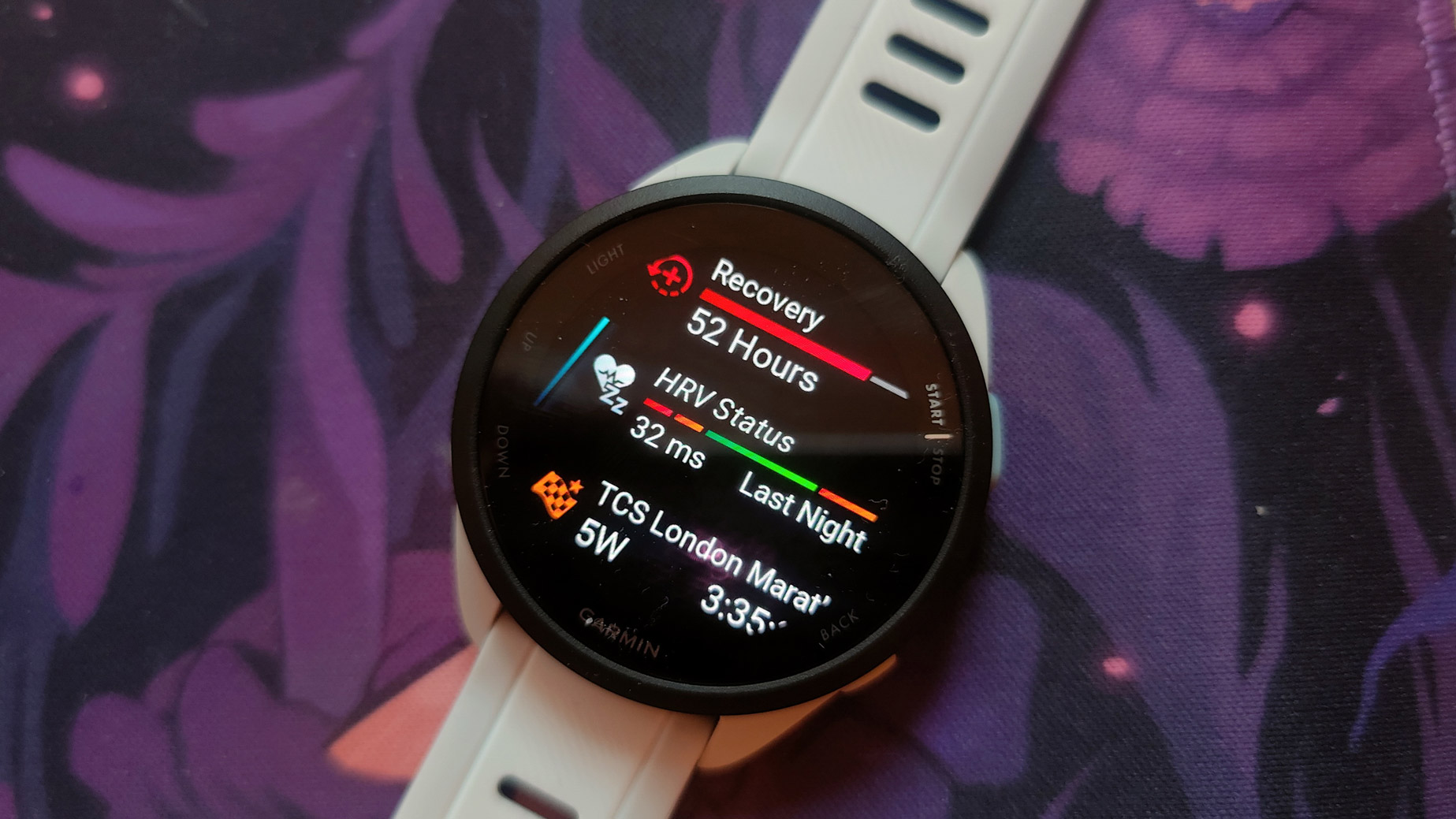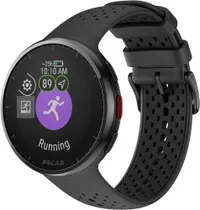TechRadar Verdict
After a few weeks of testing, the Forerunner 165 will make a very good first running watch, but doesn't have enough features for old hands. I’m pleased to see Garmin skewing cheaper with the price point, the battery lasts ages, and the screen is lovely to use. However, its features here to make it a very good buy for the price.
Pros
- +
Retains many previously-premium training features
- +
Good-looking AMOLED touchscreen
- +
13 days of battery life
Cons
- -
Not cheap enough to replace the Forerunner 45 or 55
- -
Music storage is extra
Why you can trust TechRadar
Garmin Forerunner 165: One minute review
The Garmin Forerunner 165 fills a necessary gap in its best running watches line. The very cheap Garmin Forerunner 45 and 55 watches are getting quite old, and the next stage up, the Garmin Forerunner 265 and Garmin Forerunner 965 watches, are much more expensive. So it’s nice to have an option in between those: the Forerunner 165 is a little pricey to be classified as a "cheap" running watch, but it's a high-quality entry-level item.
Starting at $299.99 / £249.99 / AU$489.95, the Forerunner 165 is a middle-ground option that retains a lot of what makes the premium Forerunners really good training companions. It’s got the AMOLED touchscreen, the ace Morning Report feature introduced in last year’s Garmin Forerunner 955, and Nap Detection as introduced in the Garmin Venu 3.
You can also create Courses in the Garmin Connect app and sync them directly to the watch, and you get race-adaptive training plans, which suggest workouts based on historic exercise and recovery data. The design, meanwhile, is very reminiscent of the Forerunner 265, right down to the profile and the redesigned ‘run’ button. The whole thing is very appealing, especially at a reduced price point, offering genuine value in terms of features.
In order to achieve this, Garmin has made a few small sacrifices, such as using chemically strengthened glass for the screen instead of the 265’s stronger Gorilla Glass, and plastic for the case instead of the heavier, harder polymers used in Garmin's more premium offerings. The battery doesn't last as long the 265's, and the watch has 4GB of storage instead of the 265's 8GB.
It’s also missing a few features in comparison to the premium watch, such as the very useful Training Readiness score, Hill and Endurance scores, and compatibility with cycling power meters. However, the inclusion of Body Battery means you've got some recovery metrics present, and the watch hits all its listed metrics in practice. It's slim and light, too, so it's easy to sleep in and comfortable to wear.
Garmin Forerunner 165: Specifications
| Row 0 - Cell 0 | Garmin Forerunner 165 |
Price | $299.99 / £249.99 / AU$489.99 |
Dimensions | 43 x 43 x 11.6 (mm) |
Weight | 39g |
Case/bezel | Fiber-reinforced polymer |
Display | 390 x 390 px AMOLED |
GPS | GPS, Glonass, Galileo |
Battery life | 11 days |
Connections | Bluetooth, ANT+ |
Water resistance | 5ATM |
Garmin Forerunner 165: Price and availability
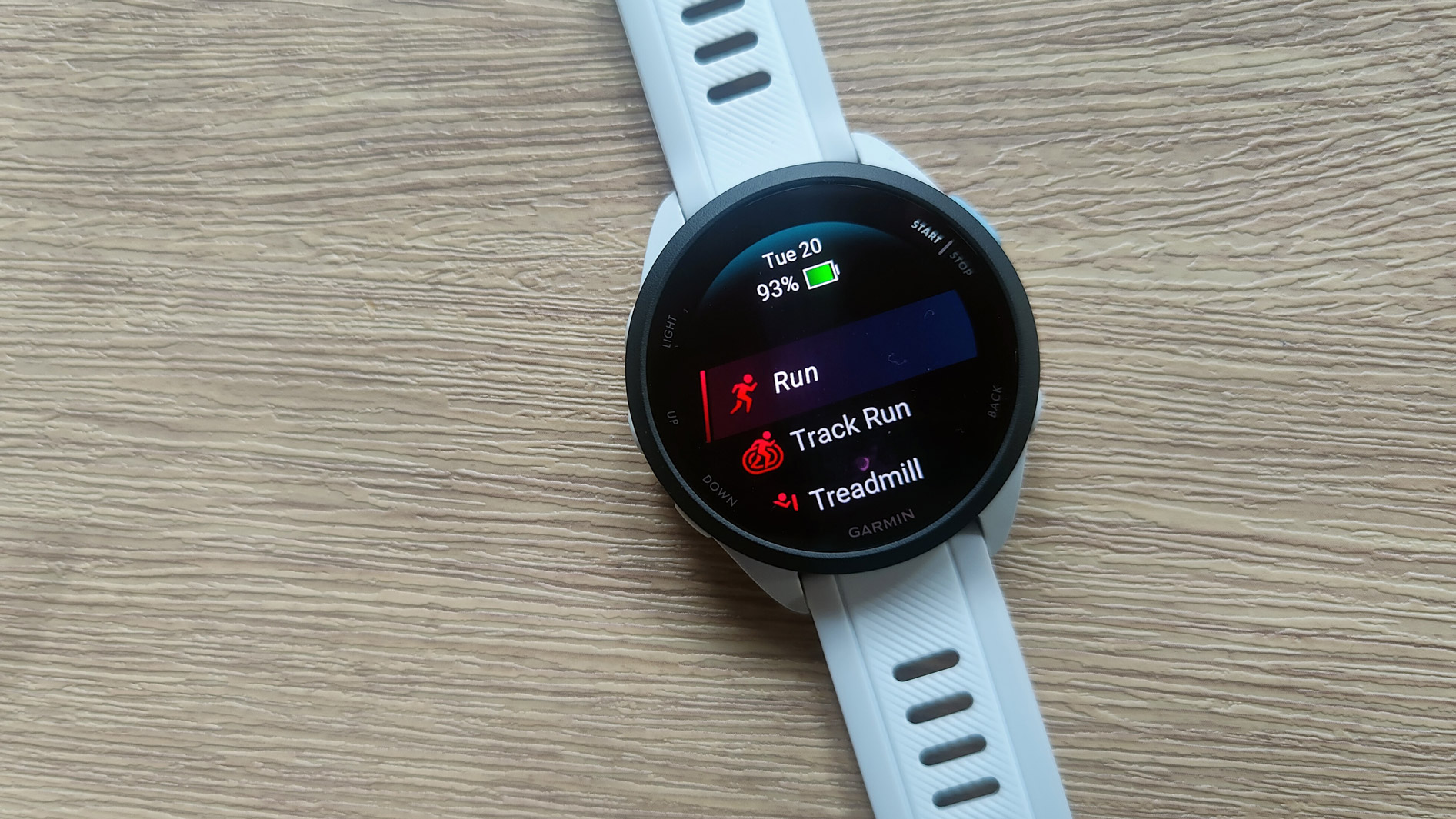
- $249.99 / £249.99 / AU$429.99
- In comparison, the Forerunner 265 is $449 / £429 / AU$770
- Music version costs extra
The Garmin Forerunner 165 is available now, priced at $249.99 / £249.99 / AU$429.99. It’s decent value, considering the 265 is much more expensive at $449 / £429 / AU$770. The older 255 is available for considerably less than the 265 these days, but you don’t get the nicer AMOLED screen or redesigned chassis that you do on the 165.
The Garmin Forerunner 165 Music, which allows you to download and store songs and playlists from Spotify, Deezer, and Amazon Music, costs $299.99 / £289.99 / $489.99.
Sign up for breaking news, reviews, opinion, top tech deals, and more.
- Value score: 3.5 / 5
Garmin Forerunner 165: Design
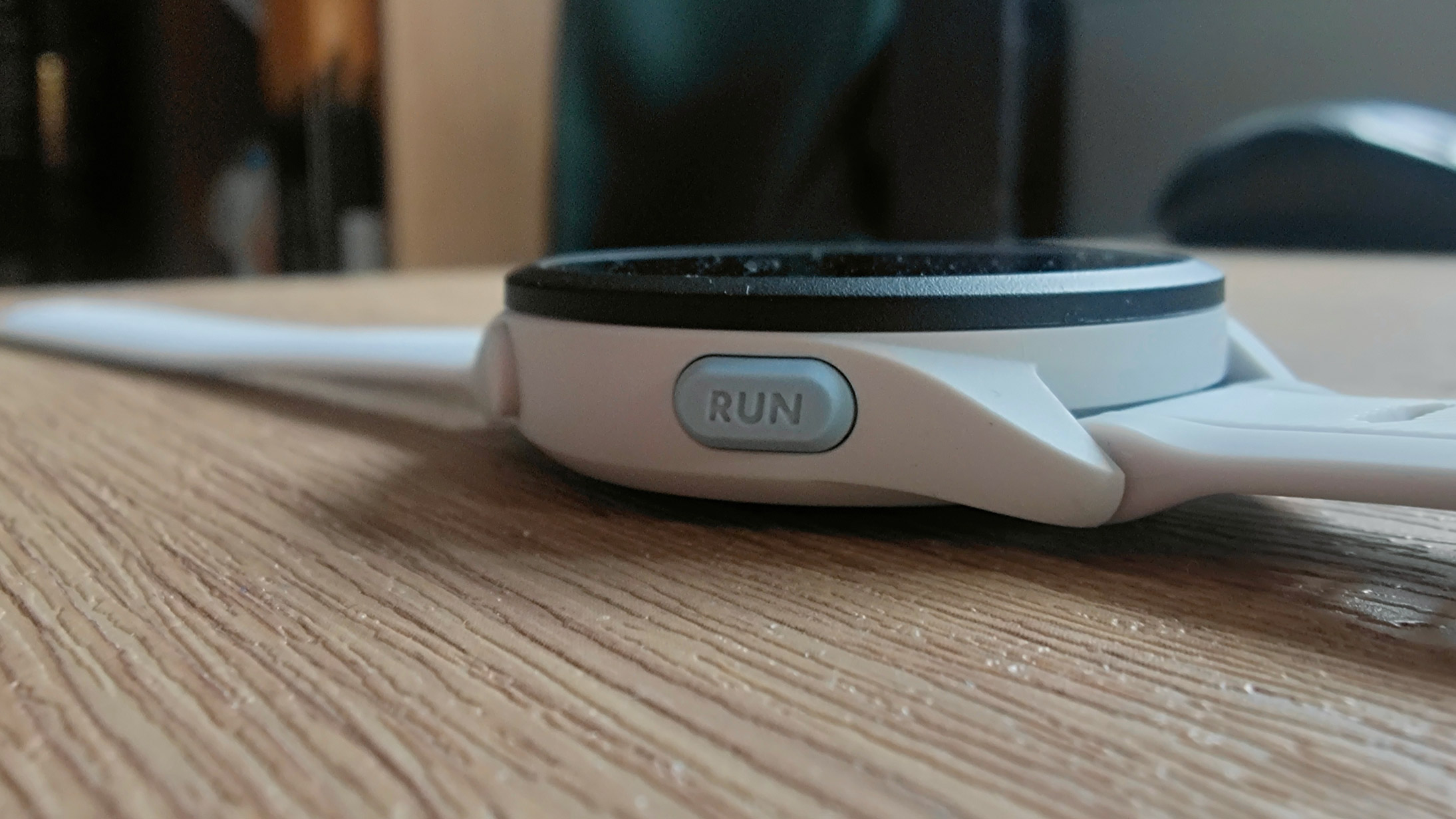
- Similar chassis as the 265
- Light and attractive
- Bright AMOLED screen
As mentioned, the Garmin Forerunner 165 shares a lot of DNA with the other Forerunners in the range. The classic Garmin five-button configuration is here, with the three buttons on the right-hand side used to navigate up and down, or wake the watch’s screen when its motion detector isn’t active.
On the left are two more buttons: a start/stop button (labeled ‘run’ on the Forerunner series) and a back button for canceling options or manually marking laps during a workout. It’s a tried and tested formula at this point, and Garmin isn't reinventing the wheel here.
The 1.2-inch AMOLED display is just as vibrant and bright as it is on the premium Epix Pro, which costs more than three times as much. However, Garmins are still training tools first and smartwatches second, and as such the 165 doesn’t have the smooth refresh rate that you might expect from, for example, the best Apple Watches. Nevertheless, it's bright during night runs and perfectly serviceable: far superior to the older memory-in-pixel display used on the Forerunner 45. After being introduced to the 265 and 965 last year, I'm glad to see AMOLED remains the standard for the Forerunner range.
Nor does it have a more expensive-feeling metal backing: it’s all 'fiber-reinforced polymer' with some plastic and silicone, much like other cheap running watches. It makes the watch feel overly light and plasticky rather than that weightier, stronger metallic feel from premium options, but doesn't impact performance. In fact, being lighter actually makes it more comfortable to wear, especially overnight. The screen is chemically-strengthened glass, so there's no durable but pricey Gorilla Glass here, which is one of the sacrifices made to keep the Forerunner 165 at a cheaper price point. Still, it’s light and comfortable on my wrist, and it looks and feels good.
The user experience is the same as with most modern Garmin watches, with their list of widgets which you can easily navigate using either the touchscreen or the five-button system. It’s easily customizable, allowing you to add or reorder widgets as you see fit from Garmin’s library to tailor the watch to your own training style.
Garmin Connect is also one of the most comprehensive companion apps in the business, with a complex design that does require scratching the surface a little, revealing a wealth of depth and potential to elevate your training. I’ll go into this more in the Features section, but nothing’s changed here: if you liked the way previous Garmin watches operate, you’ll like this watch.
- Design score: 4.5 / 5
Garmin Forerunner 165: Features
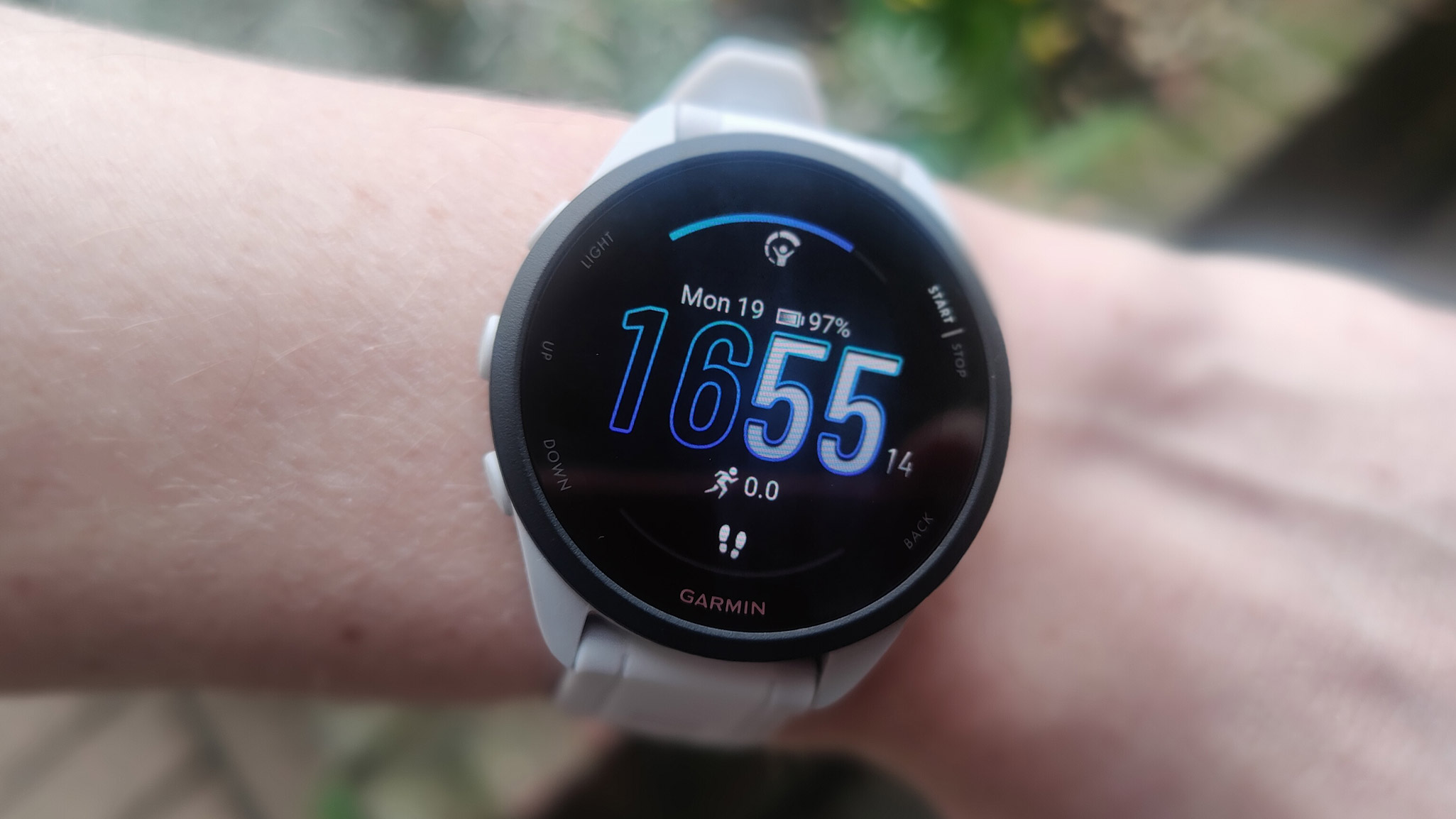
- Wrist-based running power
- Morning report and Garmin Coach are great additions
- No multi-band GPS or Training Readiness score
Garmin has added a lot of features here that I wasn’t necessarily expecting at this price point, such as wrist-based running power. ‘Power’ is an alternative method of calculating your effort that represents the total energy you’re able to put out, not just how fast your heart is beating or estimating how many calories you’ve burned. You used to need a specialist runner’s power meter measure this, as you can do for cycling, but Garmin has cracked the ability to show this number from your wrist.
Other features include the very useful Morning Report, which tells you how well-recovered you are and recommends a workout based on this stat; Course creation; and Garmin Coach, which can generate basic training plans depending on your goals. However, there's no Training Readiness score, which more accurately tells you how well you've recovered from your last workout, and this omission casts initial doubts on the accuracy of the Morning Report.
Other features sorely missed here include Hill and Endurance scores, which estimate your ability to run uphill and for long distances, respectively. When it comes to accuracy on your runs, the networks the 165 can connect to include GPS, GLONASS and Galileo, but not the Japanese QZSS or the Chinese Beidou.
Some premium Garmin watches have the capacity to connect to all five networks, ensuring good accuracy anywhere in the world, but three networks is more than enough for an entry-level watch to give the user a good approximation of distance, and I never found any problems during my tests. At this lower cost, those interested in buying the Forerunner 165 are probably enthusiast runners who don’t care about pinpoint accuracy, and just want a good estimation.
Health-wise, sleep tracking (which also contributes to Body Battery), Nap Detection, heart rate, VO2 Max, and heart rate variability are all present and correct on the easily-accessible widget list, along with a host of other widgets showing notifications, weather, a summary of the week's workouts and more. For serious runners, Race Predictor allows you to punch in an upcoming race, and it'll remind you of how long you've got until crunch time, along with a predicted time based on your training. This is based on your VO2 max and training volume, and Garmin's known for running a little fast with these (pardon the pun) but it's a useful reminder.
You do have to pay a premium for the Music version, which allows you to listen to your playlists by connecting your headphones to the watch directly, without using your phone. The Music version also offers guided workouts and performance alerts right from your watch to your headphones, which is very useful for adjusting your pace en route.
- Features score: 4 / 5
Garmin Forerunner 165: Performance
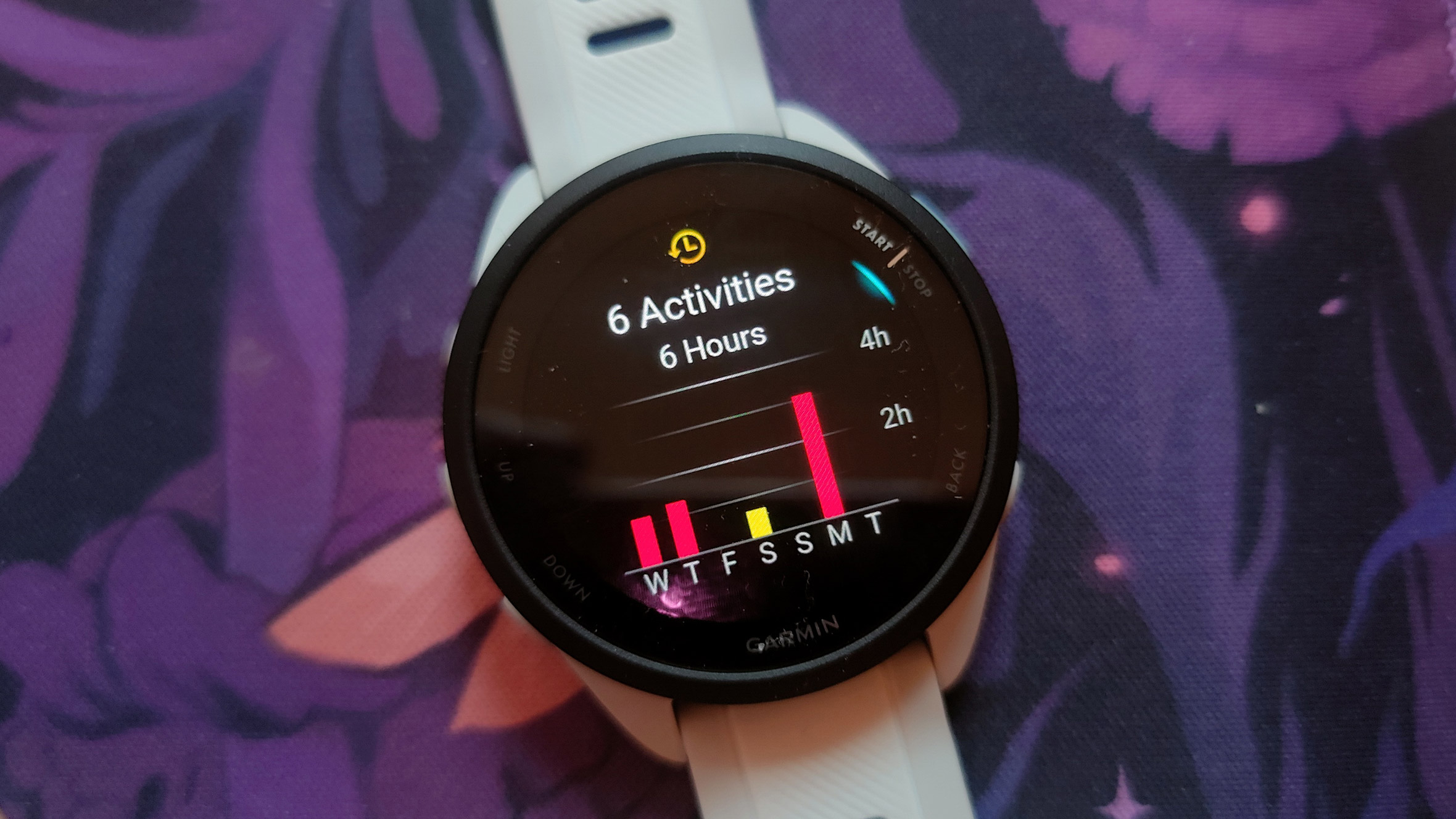
We tested the Garmin Forerunner 165 on several short and mid-distance runs, as well as in the gym. It's a comfortable wear, especially in the gym where a large, heavy watch might feel a bit more cumbersome and conspicuous, digging into your hands while lifting weights. I found the gyroscope on the 165 actually counted my bench press reps very accurately, better than many more expensive watches I've tried.
Its GPS tracking compared well with the same routes run while wearing the Garmin Epix Pro, Garmin's ultra-premium GPS watch and my personal gold standard for benchmark testing. Even with consistent GPS use, its battery lasted around nine days before needing a recharge. As the listed value was 11 days in smartwatch mode, I'd say this is accurate and reflects Garmin's listed statistics.
If this is your first Garmin (it's certainly aimed at people who haven't worn Garmins before) and you're moving away from a true smartwatch like an Apple Watch, it's hard to stress how good this is: in the time it took me to wear down the battery from full to 10%, my wife charged her Apple Watch Series 6 about six times.
The AMOLED screen, while not being as smooth as an Apple Watch, is just as good as the Epix, and during my tests I found it ergonomic to use. The widget list, the way Garmin presents its information, is a very simple layout to use and an easy one to customize.
Overall, it was a pleasure to wear, it was simple to use, fast, accurate and lasted a while. Performance-wise, it is outdone by the Coros Pace 3, which is also a plastic watch that's full of advanced features at a similar price point, but lasts up to 24 days and also offers highly advanced metrics. However, its screen is a dull memory-in-pixel display rather than a bright AMOLED one, and can less easily pass as a fully-fledged smartwatch.
- Performance score: 5/5
Scorecard

Category | Comment | Score |
Value | Not bad value at all, but I do wish it was under $200 / £200 / AU$400 to make it really affordable. | 3.5 / 5 |
Design | Bright, lovely screen, ergonomic design, lightweight with a stellar companion app. | 4.5 / 5 |
Features | Running Power and Garmin Coach are great additions at this price point. | 4 / 5 |
Performance | Performs as described: great stuff, fast and accurate with well-presented metrics. | 5 / 5 |
Garmin Forerunner 165: Should I buy?
Buy it if...
You want a great screen on your watch
The AMOLED screen is far clearer and way more... well, smartwatch-y than the memory-in-pixel display used on competitors like Coros.
You plan on investing in running
If you're looking for a great beginner's watch to take you from your first few runs to half-marathons and beyond, this is a great choice for the long haul.
You want to use training plans
Garmin's fantastic training and planning features recommend workouts, help you plan for upcoming races and generate new running routes in-app. It's great.
Don't buy it if...
You're not a runner
Sounds obvious, but if you'd rather be in the gym or the pool than on the streets, this is not the watch for you.
You're too much of a runner
Serious marathon and trail runners may want more navigation features, a Training Readiness score, and a more robust outer case. Check out the 265 for that.
Also consider
Component | Garmin Forerunner 165 | Coros Pace 3 | Polar Pacer Pro |
Price | $299.99 / £249.99 / AU$489.99 | $229 / £219 / AU$399 | $299.99 / £259 / AU$495 |
Dimensions | 43 x 43 x 11.6 (mm) | 41.9 x 41.9 x 11.7 (mm) | 45 x 45 x 15 (mm) |
Weight | 39g | 32g | 40g |
Case/bezel | Fiber-reinforced polymer | Fiber-reinforced polymer | Aluminum bezel, plastic shell |
Display | 390 x 390 px AMOLED | 240 x 240 px, always-on LCD | 240 x 240 px MIP color |
GPS | GPS, Glonass, Galileo | GPS, Beidou, Glonass, Galileo, QZSS | GPS, Glonass, Galileo, QZSS |
Battery life | 11 days | 24 days, up to 38 hours GPS | 7 days |
Connections | Bluetooth, ANT+ | Bluetooth | Bluetooth |
Water resistance | 5ATM | 5ATM | WR50 |
Coros Pace 3
The longest-lasting running watch in its price range, although the screen on the 165 is better.
Polar Pacer Pro
The aluminum case on the Pacer Pro provides a premium feel, and it's very competitively priced: essentially the same as the Forerunner.

Matt is TechRadar's expert on all things fitness, wellness and wearable tech.
A former staffer at Men's Health, he holds a Master's Degree in journalism from Cardiff and has written for brands like Runner's World, Women's Health, Men's Fitness, LiveScience and Fit&Well on everything fitness tech, exercise, nutrition and mental wellbeing.
Matt's a keen runner, ex-kickboxer, not averse to the odd yoga flow, and insists everyone should stretch every morning. When he’s not training or writing about health and fitness, he can be found reading doorstop-thick fantasy books with lots of fictional maps in them.
